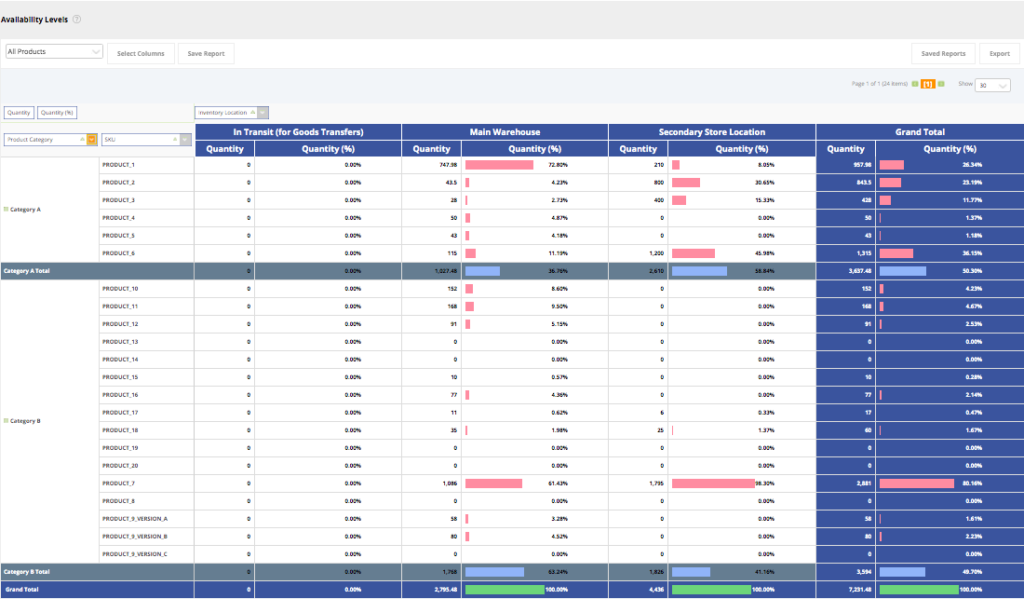5 Reasons why the service industry needs inventory management

This post is also available in:
![]()
![]()
![]()
![]()
![]()
![]()
![]()
Inventory Management might not be the first thing that comes to mind when talking about the service industry. Even if it doesn’t have the same significance as for a retailer, how you manage it still significantly impacts your service business’s success. The reason is that the quality of your services also depends on the products/materials you use to get the job done. If you’re not tracking what you have in storage or you’re only doing it with pen and paper, how can you promise a satisfying service?
In this article, we will go into depth about the special characteristics the service industry brings to the table, how inventory management differs from other industries and the top reasons why you should use a system to manage it.
Characteristics of the Service Industry
The term service describes any activity that one person can offer to another that isn’t tied to a physical product. That precondition comes with a few unmistakable characteristics that define the industry like
- Perishability: Service itself can’t be stored (obviously) and is 100% dependent on time.
- Fluctuating Demand: Demand can vary across different service businesses. A client of an electrician might only need his services twice a year, but clients of a nail salon go there every 2 weeks.
- Intangibility: Unlike a product, a service can’t be touched or even tested before its consumed.
- Inseparability: Service cannot be separated from the human creating it.
- Heterogeneity: The quality standard of service cannot be standardized. It will always be slightly different from the day before, even if it’s executed by the same person. This makes measuring service quality extremely hard.
Inventory management in a nutshell
Generally, inventory management refers to the process of managing the flow of goods throughout the whole supply chain. This includes everything from monitoring stock levels, purchase and sales orders, supplier and client relationships, and making business decisions based on reporting. For the retail industry, for example, products are their core business. Another activity tied to inventory management is inventory control which is the daily process of monitoring stock levels. This can also be important for a service business such as a hair salon that needs to make sure it has shampoo in stock before offering clients a wash.
Inventory management in the service industry goes beyond simply knowing what products you have on hand; it’s about efficiently managing your resources to ensure that you can always deliver top-notch service. This includes leveraging the best purchase order software to streamline your procurement process. By automating purchase orders, you not only save time but also ensure accuracy and consistency in your ordering process, which is essential for maintaining the quality of service that your customers expect.
How is inventory management in the service industry different from others?
Traditionally, someone would think of big warehouses, containers, and retailers in relation to inventory management. But even though service is intangible, having the right products to accompany it can make a big difference to the consumer. As mentioned previously, inventory management includes activities along the whole supply chain. Look at this visual to see the difference between the regular supply chain and the service supply chain.
Additionally, utilising professional inventory management services can further refine the supply chain processes in a service-oriented environment, ensuring that the right products are always available to complement the service delivery.
As you can see, a service business doesn’t start with raw materials and doesn’t include a manufacturing part. We could even say that a service business is the client of the regular supply chain as it buys products to go along with the services offered.
What are the different types of inventory in service businesses?
Let me give you a few examples if you’re still unclear about what inventory service businesses might have.
One of the service industry’s most prominent and known subcategories is the Food & Beverage Industry. As the name suggests, food and drinks account for the majority of inventory. Additionally, anything that accompanies or is needed in order to prepare it counts as inventory. That can be plates, glasses, tablecloths, but also kitchen machinery, pots and pans, and so on.
Another major service-based industry is the hospitality industry. Did you know hotel rooms in and of themselves count as inventory of the hotel? When vacant rooms remain, that inventory was not sold, or, another example, if you rent a two-bedroom to only one person, it is considered half-sold. You see, inventory doesn’t always need to be tangible. It can also be intangible.
In the fitness industry, a personal trainer can be as much part of the inventory as a dumbbell. It always depends on what your business offers, a lot of gyms, for example, offer branded products or vending machines to make an additional profit. If they do so, they have to consider inventory holding costs (if they don’t make a lot of sales) and ensure the security of the products.
When it comes to service businesses based in the construction industry, like plumbers and electricians, they mostly deal with MRO inventory. This includes items that are necessary for maintenance and repair activities.
5 Reasons why the service industry needs inventory management
Now that we’ve established what inventory service businesses hold let’s look at why the industry needs to manage it professionally. These benefits count toward the management of tangible products. To make sure that intangible inventory, like the mentioned personal trainer, has capabilities, companies should use scheduling software for organizational purposes.
More Productivity & Control
With the right inventory management system, you can save time looking around for the right products you need or getting into trouble because you don’t have something available. Automation is generally the best way to increase productivity in a business as it minimizes human errors and increases visibility. Also, controlling your inventory on a regular basis will save you time at the end of the year when you need to do the annual count.
Avoid waste
Especially in the F&B industry, food waste is a big problem. Monitoring the flow of goods in and out of the storage room can help determine the fluctuating demand in businesses. Planning what you need daily based on common patterns will optimize the replenishment process. Additionally, you can be a part of companies like Too Good To Go to sell your products for a smaller price at the end of the day.
Cost savings
By reviewing your inventory holding costs, carrying costs, etc., you can adjust the amount of inventory you need to buy to be profitable. A fitness business could determine what supplements are doing well and which ones can be taken out to save costs.

Customer Satisfaction
Forecasting methods will allow you to deliver better on your client’s expectations and track whether you have their favorite products ready to use.
Stay Competitive
Staying on top of your inventory management will give you a competitive advantage as opposed to other service businesses. Especially because many companies in the industry might not think that it’s important for you to be one of the organized ones. Remember, knowledge is power. Knowing what you have and what you need, as well as having a system behind it, makes work more pleasant for your employees and simplifies order processes as well. Effective ecommerce warehousing solutions can further streamline inventory tracking, ensuring timely deliveries and minimizing stock shortages.
How to manage inventory successfully for your service business
Here are a few tips to get you started with inventory management for your service business.
Audit & Organize your products
When you’re still at the beginning, start by doing an initial audit of your inventory and organizing them according to products. This will make it easier to set up a system successfully from the start, and if you decide to get help, it makes it easier for the software support to import your data.
Track stock levels with a cloud-based inventory software
Make yourself and your team familiar with the new software. Don’t hesitate to reach out to the support team if you’re struggling with something. Most vendors offer 24/7 service to solve problems when they arise. And the most important tip: actually use the software. Many businesses acquire the software and due to a lack of time and because it’s easy to just continue with old habits, they don’t make the most of what they’re paying for.
Run reports on product consumption & availability levels
Product consumption and availability reports are the most helpful when it comes to managing your inventory. A good system should show you in an uncomplicated way what you need to know in order to optimize processes.

Take a look at your supplier relationships
If you have the time, reconsider where you’re getting your products from. If you have been using the same supplier for a long time, maybe it’s worth looking for better (and cheaper) alternatives out there now.
Wrapping Up
Implementing inventory management software can help businesses get ahead of the competition and track what their clients want in stock. When done right, it can also make your employee’s life easier and free up valuable time that can be used elsewhere.
Author’s Bio

Svea Schüler is Online Marketer at Megaventory, a SaaS company for inventory management for small and medium-sized businesses. She believes content and social media marketing are the best ways a brand can create awareness and secure long-term customer satisfaction. Outside of work, you can find her weightlifting in the gym or cooking with friends.



Comments
0 commentsNo comments yet